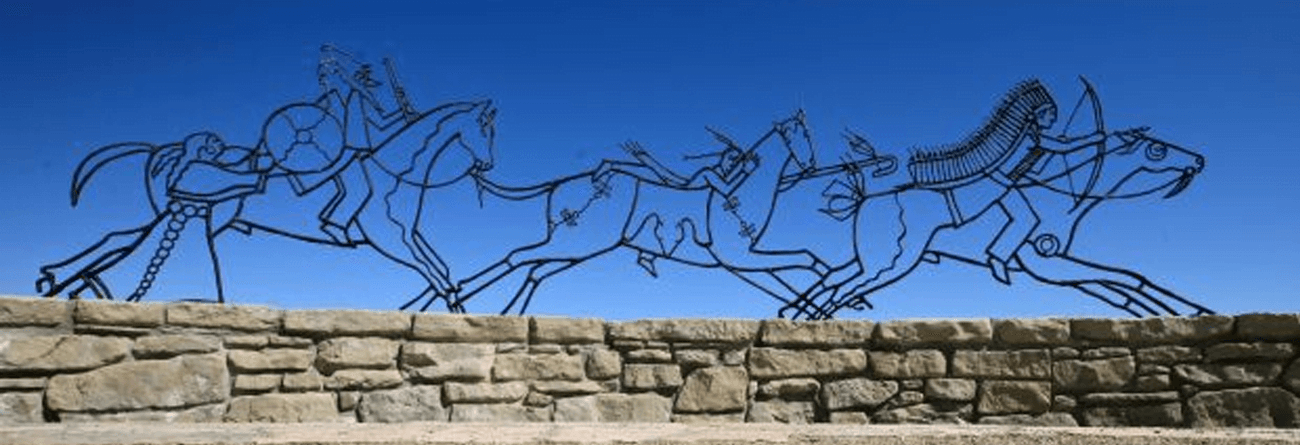Just across the Wyoming/Montana state line, an unassuming monument stands on the prairie. You might even drive past it without knowing the significance of that plot of tall grass on a hill overlooking more rolling hills. The feeling when you stop, however, is unmistakable. It’s the sense of peaceful anticipation you feel while standing in a cemetery, calm but on edge- And it should feel that way, considering the history of that plot of land with monuments raised above the prairie. It’s a battlefield, but from a battle long lost by US forces.

The Little Bighorn Battlefield is not just an interesting historical tidbit- it’s an example of the strife and struggle of the indigenous peoples to these lands when manifest destiny brought US men into the west to try to “civilize” it. Even today, the spirit of the battle rages in the west, and the hubris of the commanding officer turned this battle into a slaughter.
In 1876, forces met on these rolling hills near the Little Bighorn River, specifically, US Army’s 7th Cavalry and the Lakota and Cheyenne who were defending their homelands. The Cavalry was led by the infamous George Custer, with the opposing side following famous names like Sitting Bull and Crazy Horse into battle, again, with those invading their lands. By this point, the war had been raging for several years, beginning with the treaty of Fort Laramie in 1863, when the US promised the western half of South Dakota, including the black hills, as a reservation for members of the Lakota and Cheyenne tribes. While many were unhappy with the situation, they were even more incensed when the US settlers broke the treaty after gold was discovered in the Black Hills. Today, you will find Mount Rushmore on that land, carved into the mountain once known as Six Grandfathers by the Lakota.

The battlefields near the Little Bighorn River are infamous as the location where Custer made his Last Stand, with 263 soldiers who were slaughtered by the over 1500 indigenous warriors. The memories the land holds include desperation, fear, death, and for the indigenous warriors– victory. The death of Lt. Col. Custer in the two-day skirmish would cause an uproar in the US citizenry, who resolved to take the land by force and “put down,” the rebellion of those native to the region. Within a year, the indigenous forces would surrender and the Black Hills would be taken by force without compensation.
The amount of death seen by these rolling hills is staggering, with hundreds of markers noting where bodies of the two sides had fallen to the ground and never rose- Custer himself included. Monuments to both the 7th Cavalry and the Lakota and Cheyenne look over the hills in silent reverie. However, the fields aren’t always so quiet these days.
Like other battlefields out east, the trauma of war left behind ghostly activity and unexplained appearances of long-dead soldiers. If you listen carefully, legend says you can hear the anguished screams of the slaughter on the battlefield. Appearances of men in period clothing are common, but they always seem to disappear seconds after being spotted. One man detailed touring the battlefield and seeing a man in 1870s cavalry attire ahead of him– when he noticed that the man wasn’t moving any of the tall grass he was walking through. The soldier disappeared after a few seconds staring across the field where he likely lost his life over 120 years prior.

A park ranger and member of the Crow tribe, Mardell Plainfeather, detailed her experience with friendly native American spirits on the site, specifically two men dressed in Lakota war regalia and feathers sitting on horseback at the top of a hill. They observed her for a few moments before disappearing in the moonlight. The next morning, no evidence of horses or tricks of the light could be found, so the ranger had no choice but to pray for the dead and hope their appearance was one of kindness and not of anger.
The most haunted location on the site is said to be the 1894 Stone House, built originally for the cemetery caretaker. Today it’s known for lights flickering on and off, poltergeist activity, and deadbolting doors from the inside. Apparitions have also been reported near the visitor center; including the infamous Lt. Col. Custer himself, wandering the grounds in his stately uniform.
The blood spilled on the grounds certainly seem to have kept a few of those involved in the battle wandering the cursed lands in their afterlife. Located on the Crow Agency, this monument is equal parts horrifying and peaceful, with history woven into every square inch of the location. If you’re brave enough to visit, try to go out early in the morning or later at night, as local employees say the activity is heavier at sunrise and sunset. So be prepared to watch the sunset with a ghost or two… or 300.
- About the Author
- Latest Posts

Born in Death Valley and raised on the prairie, Deborah is a Wyoming-based paranormal researcher and University of Wyoming graduate. Her interests lie in folklore, history, symbolic interaction and research. She also researches the paranormal academically and is a graduate student studying sociology.


